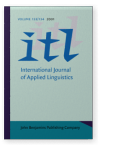Vol. 133/134 (2001) ► pp.325–345
Vol. 133/134 (2001) ► pp.325–345
Japanese EFL Learners' Processing in English Relativization
The purpose of the present study is to investigate the effects of branching type (Factor 1) and grammatical function of noun phrase (NP) (factor 2) of English relative clauses on interlanguage performance among Japanese learners of English as a foreign language (EFL). The sentence combining test was administered to Japanese learners of English. Results indicated that both of the two factors significantly determine the difficulty of English relative clauses. Left-branching (center-embedded) relative clauses have a tendency to be more difficult than right-branching ones. Moreover, it is implied that subject-relative clauses are answered more accurately than object-relative clauses. These findings suggested that branching type and grammatical function of the noun phrase are complimentary determine the difficulty level of English relative clauses. The results implied the validity of KAWAUCHl's (1988) hypothesis that the difficulty order of relative clauses is as follows : OS > 00 > SS > SO. The results are also discussed with the recent theoretical frameworks in psycholinguistic research. The limitation of the present investigation and the directions of the further research are also discussed.
